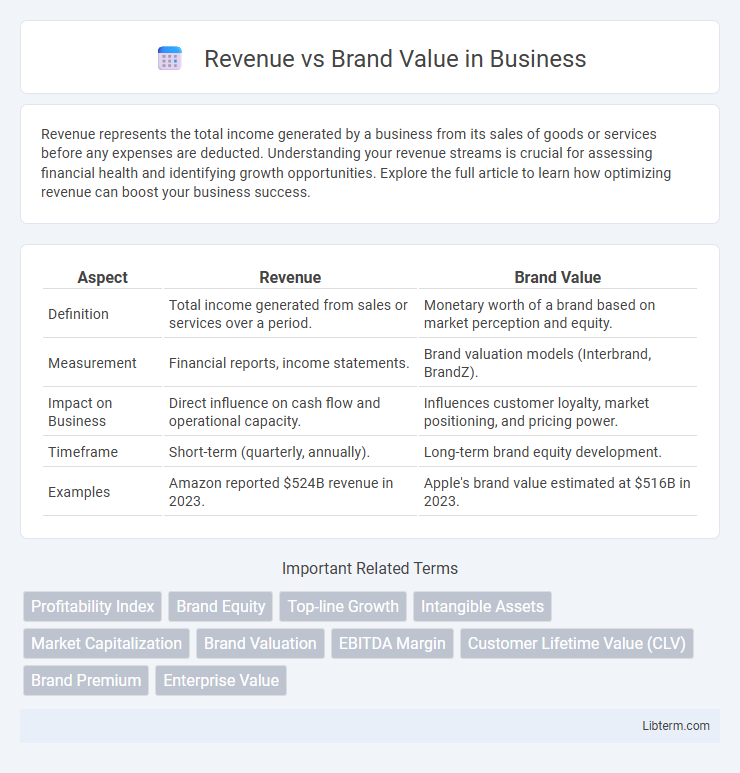Revenue represents the total income generated by a business from its sales of goods or services before any expenses are deducted. Understanding your revenue streams is crucial for assessing financial health and identifying growth opportunities. Explore the full article to learn how optimizing revenue can boost your business success.
Table of Comparison
| Aspect | Revenue | Brand Value |
|---|---|---|
| Definition | Total income generated from sales or services over a period. | Monetary worth of a brand based on market perception and equity. |
| Measurement | Financial reports, income statements. | Brand valuation models (Interbrand, BrandZ). |
| Impact on Business | Direct influence on cash flow and operational capacity. | Influences customer loyalty, market positioning, and pricing power. |
| Timeframe | Short-term (quarterly, annually). | Long-term brand equity development. |
| Examples | Amazon reported $524B revenue in 2023. | Apple's brand value estimated at $516B in 2023. |
Understanding Revenue and Brand Value
Revenue represents the total income generated from sales of goods or services, providing a clear measure of a company's financial performance within a specific period. Brand value reflects the market perception and strength of a brand, often quantified through customer loyalty, recognition, and competitive advantage, influencing long-term profitability. Understanding both revenue and brand value helps businesses balance immediate financial results with sustained brand equity growth.
Key Differences Between Revenue and Brand Value
Revenue represents the total income generated from goods or services sold during a specific period, reflecting a company's operational performance and financial health. Brand value measures the intangible asset strength, encompassing customer perception, loyalty, and market influence that contribute to long-term competitive advantage. While revenue quantifies immediate financial success, brand value indicates sustained consumer trust and future earning potential.
How Revenue is Generated
Revenue is generated through the sale of goods or services, driven by customer demand and market positioning. Effective pricing strategies, sales volume, and distribution channels directly impact the total revenue a company earns. Brand value influences long-term revenue potential by enhancing customer loyalty and premium pricing but does not directly generate immediate income.
Factors Influencing Brand Value
Brand value is influenced by factors such as brand reputation, customer loyalty, market presence, and emotional connection with consumers, which do not directly correlate with immediate revenue figures. High brand value often stems from consistent quality, strong marketing strategies, and positive customer experiences that build long-term trust and differentiation in competitive markets. Although revenue reflects short-term financial performance, brand value encompasses intangible assets that drive sustained business growth and premium pricing power.
Measuring Revenue: Methods and Metrics
Measuring revenue involves analyzing financial statements, sales data, and cash flow to capture accurate income generation over specific periods. Key metrics include gross revenue, net revenue, recurring revenue, and revenue growth rate, which provide insights into business performance and market demand. Effective revenue measurement supports strategic decisions, resource allocation, and forecasting, differentiating it from brand value assessment which centers on customer perception and brand equity.
Evaluating Brand Value: Tools and Strategies
Evaluating brand value involves leveraging tools such as Interbrand's Brand Valuation, BrandZ, and Brand Finance, which assess financial performance, brand strength, and market influence. Strategies include conducting customer perception surveys, analyzing brand equity metrics, and monitoring social media sentiment to capture intangible brand assets beyond revenue figures. Understanding these elements provides a comprehensive picture of how brand value drives long-term business sustainability and competitive advantage.
The Relationship Between Revenue and Brand Value
Revenue directly influences brand value by providing the financial resources needed to invest in marketing, innovation, and customer experience, which enhance brand equity. Strong brand value, in turn, drives customer loyalty and pricing power, leading to sustained revenue growth. The symbiotic relationship means companies with higher revenue can build stronger brands, while valuable brands generate more consistent and scalable revenue streams.
Impact of Brand Value on Long-term Revenue Growth
Brand value significantly influences long-term revenue growth by enhancing customer loyalty and enabling premium pricing strategies. A strong brand reputation fosters trust and differentiates products in competitive markets, leading to sustained sales increases over time. Companies with high brand equity often experience more stable revenue streams and greater resilience during economic fluctuations.
Case Studies: Companies Excelling in Both
Amazon and Apple exemplify companies excelling in both revenue and brand value through strategic innovation and customer-centric approaches. Amazon's revenue surged past $500 billion in 2023, driven by diversified services including e-commerce, cloud computing, and streaming, while its brand value reached $460 billion, ranking it among the top globally. Apple generated $400 billion in revenue and maintained a brand value exceeding $500 billion by consistently delivering premium products and fostering strong brand loyalty worldwide.
Building Strategies for Balanced Growth
Revenue growth hinges on effective sales optimization and market penetration, while brand value depends on consumer perception and long-term trust. Building balanced growth strategies requires integrating data-driven marketing, product innovation, and consistent brand messaging to align financial performance with brand equity. Leveraging customer insights and investing in both short-term revenue drivers and long-term brand assets creates sustainable competitive advantage.
Revenue Infographic

 libterm.com
libterm.com